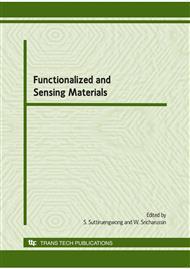p.553
p.558
p.562
p.566
p.570
p.574
p.578
p.583
p.587
CoPc/CdS Hybrid Photovoltaic Device
Abstract:
The organic-inorganic hybrid photovoltaic (PV) cells based on cadmium sulphide (CdS) and cobalt phthalocyanine (CoPc) films have been fabricated and characterized their PV performance. This investigated the effects of the organic and inorganic layer thickness on the photovoltaic properties, these thickness was controlled at various values such as 10, 30 and 50 nm. However, the performance of the hybrid photovoltaic cells was depending on the organic layer thickness. The optimize results of PV cell with CoPc 10 nm and CdS 30 nm showed an open-circuit voltage (Voc) = 0.536 V, a short-circuit current density (Jsc) = 0.1020 mA/cm2, a fill factor FF = 0.281 and a power conversion efficiency (η) = 0.01536 % under the AM1.5 conditions. Efficiency is enhanced by 22 times with the addition of a buffer layer, bathocuproine (BCP) 5 nm, the power conversion efficiency (η) value from 0.01536 to 0.34571%.
Info:
Periodical:
Pages:
570-573
Citation:
Online since:
January 2010
Authors:
Price:
Сopyright:
© 2010 Trans Tech Publications Ltd. All Rights Reserved
Share:
Citation:


